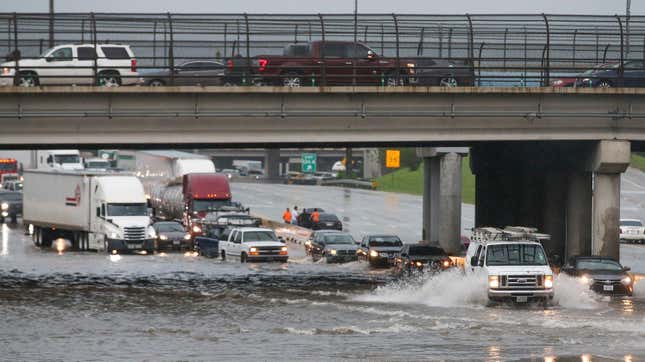
The U.S. recently passed a $1 trillion bipartisan spending bill aimed at improving and repairing the country’s decaying infrastructure, but a new report on flooding risks resulting from climate change warns even more investment might be needed.
Within the next 30 years, sea level rise and more intense downpours could put around 26% of U.S. roads underwater on the regular. Nearly 40,000 critical infrastructure facilities, including airports, fire stations, and hospitals, may be at risk of flooding as well.
Those are just a few of the dire findings within a recently released, multiyear analysis conducted last month by nonprofit group First Street Foundation. The report found there are already around 2 million miles (3.2 million kilometers) of U.S. roads at risk today, and another 200,000 miles (320,000 kilometers) will be put in the danger zone in the coming decades.
In addition to roads and critical infrastructure, the study looked at the impact increases in climate change-linked flooding will have on social infrastructure, (think government buildings, churches, and museums) and residential and commercial buildings. The risk from flooding to residential properties is expected to swell 10% over the next 30 years, putting around 13.6 million properties at risk of flooding, while commercial properties are expected to see a 7% increase in flood risk over that same period.
Overall, coastal roads in Louisiana and Florida face the highest levels of flooding threats, with New Orleans and Miami considered the cities most at risk. Combined, these two coastal cities have around 1 million residents who are already facing the impacts of rising seas and heavier downpours. According to the study, 17 of the top 20 most at-risk counties to flooding damage in the U.S. were confined to Louisiana, Florida, Kentucky, and West Virginia.
In Monroe County, located in the Florida Keys, seawater on the roads has already become much more common, especially during king tides that hit the state each fall. Rising seas have boosted the tides, forcing officials to consider dramatic—and costly—measures. In an interview with WPTV, Monroe County Chief Resilience Officer Rhonda Haag said she worries about what’s in store for the 322 miles (520 kilometers) of local roads the county maintains as seas continue to rise.
“It’s been known as a nuisance,” Haag told WPTV of seawater rises. “But when it gets to that level of water and it’s on for a tremendous period of time, it’s no longer a nuisance. It’s a real problem.” However, solutions to these problems on the local level don’t come cheap.
According to Haag, elevating the roads in Monroe Country to offset the flooding’s reach could cost $1.8 billion. That’s just the tip of the iceberg, with communities across the U.S. direly in need of floodwater infrastructure upgrades. Beyond elevating roadways, improving stormwater infrastructure, planting trees and nourishing marshlands, and other solutions could help buffer Americans from rising waters.
This isn’t a wait-and-see situation either. Flooding is already taking a major toll in U.S. cities across the country. Notably, more than half of the critical infrastructure in Harris and Miami-Dade counties, two of the largest counties in the country, is at risk of flooding today. The past six months alone have also been a case study in monster floods driven by rain and storm surge in every region of the country. The damage has been costly and widespread, ranging from subway stations filling with rainwater to road washouts. The cost to protect so much infrastructure is astronomical—but the alternative of doing nothing could be even more costly.